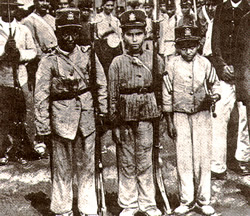
No lecture on Thursday -- Discussion Sections meet!!
Thanks to Kate Novotny for this article on U.S. 'neocolonial' collecting in Peru
The Library of Congress on William Walker in Nicaragua
*********************************************************************

Gran Colombia entered the 19th century with a colonial inheritance of intense socioracial hierarchy, marked regionalism, almost no transportation system, and a rugged geography, see map ---all of which are visible in this color plate from a 19th-century Colombian geographic commission (see Carlos Valencia Editores, En busca de un país: la comisión corográfica (Bogotá: 1984)). It depicts an Arawak man carrying an upper-class traveler through the forests of the Chocó. Even after steam navigation began on the Magdalena River, it took people 4-6 weeks to travel from the coast to Bogota. At the beginning of the 20c, it was cheaper to transport goods from Liverpool to Medellín than from Medellín to Bogotá, and the two cities were not linked by rail until the 1930s. Only with the advent of the automobile and the airplane did some of the separation between Colombia's three main regions, separated by mountain ranges, begin to be overcome.
The wars that come and go in the lives of Macondo's residents parallel the nation's violent history, marked by major armed conflicts between the Liberal and Conservative parties: 1839-41,1854,1860-62,1899-1902. This last conflagration is known as the War of the Thousand Days, and was the war that GGM heard stories about from his grandfather, a veteran, during his childhood in Aracataca. It ended with a Conservative victory ratified in the Treaty of Neerlandia.
 Historical photographs from the period of the War of the Thousand Days provide useful, evocative images of the violence depicted in One Hundred Years. The Liberal General Rafael Uribe Uribe led a populist challenge to the elite power-sharing agreement established after the war, but lost this battle as well. Like Coronel Aureliano Buendía, in losing he became a mythical popular hero, but ended his life fighting for nothing greater than soldiers' pensions.
Historical photographs from the period of the War of the Thousand Days provide useful, evocative images of the violence depicted in One Hundred Years. The Liberal General Rafael Uribe Uribe led a populist challenge to the elite power-sharing agreement established after the war, but lost this battle as well. Like Coronel Aureliano Buendía, in losing he became a mythical popular hero, but ended his life fighting for nothing greater than soldiers' pensions.
Through the 20th century, photographs from the war kept alive the memories of both heroism (as in the endlessly reproduced portraits of generals) and violence, an example of which is this horrific photograph, ca. 1903 of a pile of skulls from the small town of Palonegro, where an estimated 2,500 people died. The war mobilized huge segments of the population, from the women who both fought with and followed the armies (collectively remembered in Colombian folklore as "las Juanas") to the boy-soldiers that sometimes ran off to join troops that seemed heroic and sometimes were violently conscripted. Women can be seen in this 1901 photograph of Conservative volunteers camped beside Bogota's panopticon, while Colombia's boy soldiers were explicitly the subject of perhaps the single most famous photograph of the war, taken by a foreign journalist in 1902 and published in the Parisian magazine L'illustration.
One year after the War of the Thousand Days ended, the United States attempted to ratify its interest in the canal zone of Panama, which belonged to Colombia. Panama declared independence under the protection of the US Navy, canal rights were signed over to the US (with no native Panamanians present), and the US recognized the new republic in 1903. Indemnity payments to Colombia were a sore point for years. But in 1914, a fee of 25 million was agreed upon. These indemnity payments helped fund Colombia's economic "dance of the millions" some 30-40 years later than much of the rest of Latin America, in coffee (controlled mostly by Colombian elites) and bananas (controlled mostly by North American companies).
Macondo, from a Bantu word meaning banana, was the name of an abandoned banana plantation in the Magdalena region where GGM grew up. It was owned by United Fruit Company, now Chiquita. The massacre of the banana workers is modeled after an incident in Ciénaga that occurred in December, 1928.